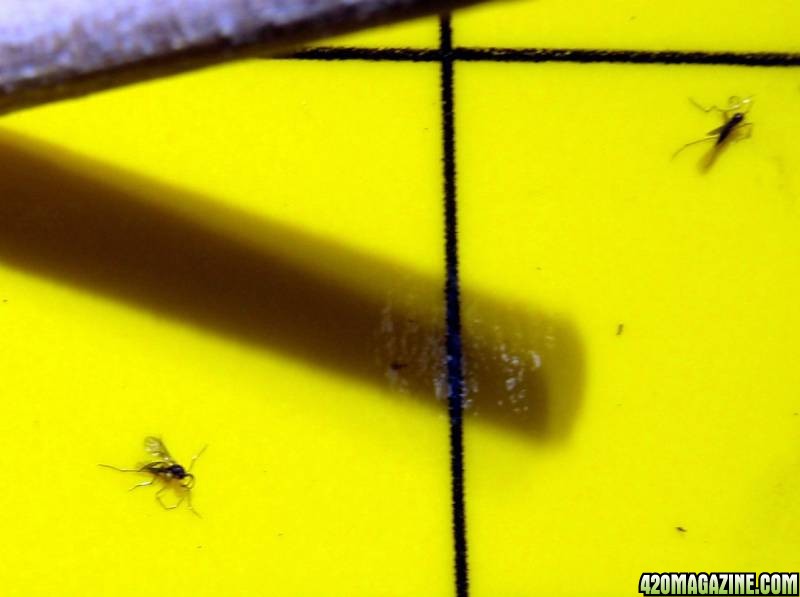I ran across a good article on fungus gnats:
From:
Welcome to the Minnesota Department of Agriculture
Description
Fungus gnats (family Sciaridae) are found in and around damp areas such as wet floors or benches with decaying vegetable matter, algae, and/or fungi present. Adult female fungus gnats lay eggs in soil or growing media. The eggs hatch into larvae that feed on plant roots. As their name suggests, the wings of adult dark-winged fungus gnats appear light to dark gray.
Unlike houseflies or other kinds of flying insects, adult fungus gnats tend to remain near plants (in indoor situations) at soil level and can be found resting on leaf litter and foliage. Larvae dwell in the soil until they pupate; they are legless and have transparent bodies with distinctly black head capsules. Pupae are difficult to detect without magnification, but are stouter and more brown than larvae.
Life Cycle
Female adult thrips deposit oval eggs under the soil surface. The following are the life stages and their approximate duration*:
1. Egg (hatch in 4-6 days)
2. Larva - four instars (10-14 days)
3. Pupa (5-7 days)
4. Adult (lives about 7 days)*
*Adult females can lay up to 1000 eggs in a lifetime!
Damage
Fungus gnat larvae feed on various parts of plant roots and generally diminish plant health. Plants infested with fungus gnat larvae can show signs of stunted growth. Larval feeding can also spread plant pathogens and/or make plants more susceptible to disease. Although adult fungus gnats can help spread pathogens, they do not feed on or otherwise harm plants and are considered a nuisance when they occur in indoor settings such as offices, malls, and apartment buildings.
Control Strategies
Monitoring for adults. Regular monitoring for winged adults using yellow sticky cards will help identify a fungus gnat infestation in its early stages. Disturbing the foliage of plants suspected to be infested will cause fungus gnats to leave plants, and can help trapping efforts. Trapping alone is not recommended as the sole means of control, but when used in conjunction with other methods can reduce significant numbers of adults.
Physical and cultural controls. Do not overwater plants. Keep growing areas as dry, algae-free and weed-free as possible. Pull and bag weeds that may harbor pests. For office and home situation with a relatively few number of plants, cover entire soil area with plastic wrap to prevent adult emergence and egg laying.
Chemical controls. Although the use of insecticides to control fungus gnats on small numbers of indoor plants is not recommended, pyrethrins or pyrethroids may provide short-term relief from adult gnats. (See Physical and cultural controls.) For commercial growing operations, consider adding a biological insecticide such as Bacillus thuringiensis subspecies israelensis to growing media. For more information, consult your local pesticide product dealer to see what works best for your situation.
Biological Control. Several species of beneficial nematodes are available to help keep fungus gnat larvae in check. Other predators such as rove beetles (family Staphylinidae), ground beetles (family Carabidae), and soil centipedes (family Geophilidae) may occur naturally in your growing area. Predator mite Hypoaspis miles and biological insecticides such as Bacillus thuringiensis can be applied to growing media to control fungus gnat larvae. Consult a supplier of biological control agents to see which agents will work best for your situation.
Predators. Soil-dwelling predator mite Hypoaspis miles; rove beetles such as Atheta sp. (family Staphylinidae).
Parasitoids. Synacra pauperi parasitizes the larval stage of fungus gnats. (Note: S. pauperi is not yet commercially available in the U.S., but is being used in Europe for fungus gnat control in mushroom houses.)
Nematodes. Steinernema carpocapsae or Steinernema feltiae nematodes attack the soil stages of fungus gnats. Consult with a supplier of beneficial nematodes to find out how to apply nematodes and about other beneficials that can be used in conjunction with nematodes for additional control.







